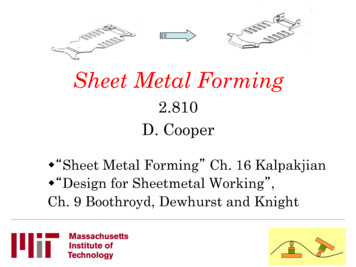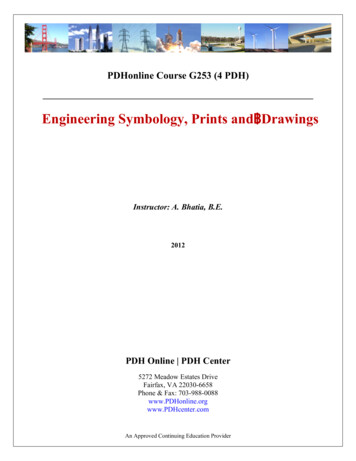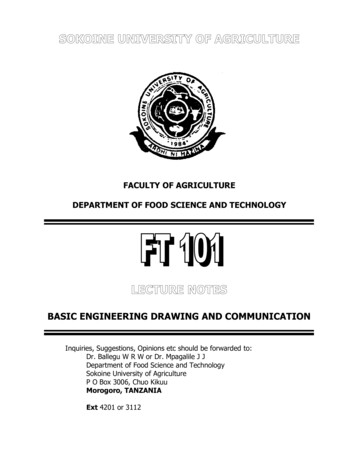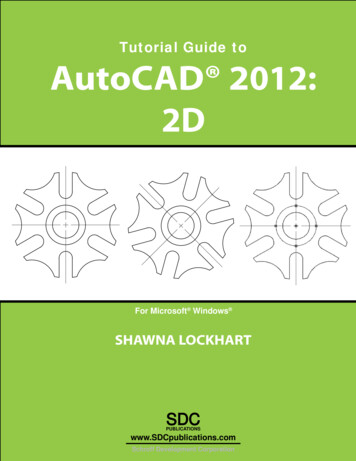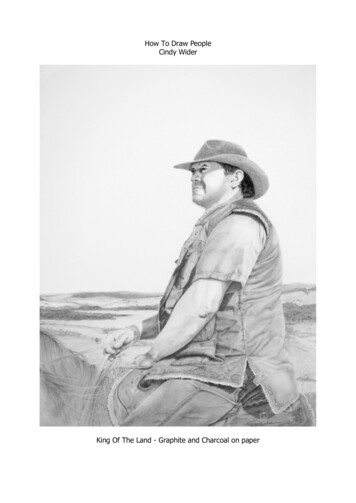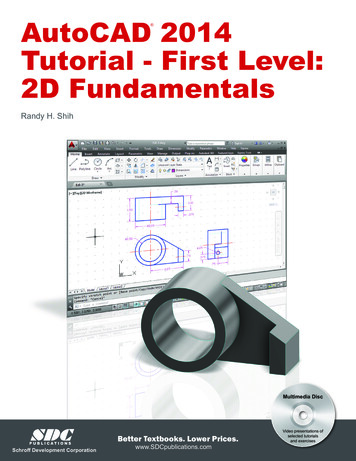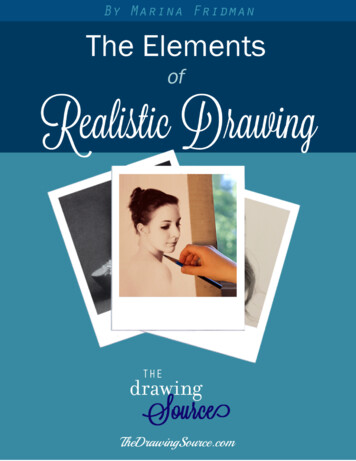
Transcription
1 The Elements of Realistic DrawingTheDrawingSource.comThe ElementsofRealistic DrawingWritten by Marina Fridman ofwww.TheDrawingSource.comDisclaimer:Please note that the methods presented in this publication are based on the author’s experience and education inrepresentational drawing. They are by no means the only way to draw, or learn to draw. It is natural that some willtake to methods and teaching styles other than the ones presented in this E-Book.No part of this E-Book may be copied or reproduced. This E-Book may be shared in its entirety only. It may not betaken apart or altered in any way. The author would prefer that the E-Book be shared by directing whomever youwish to share it with to this link: html so that they maysubscribe to receive their free copy.Copyright 2020 Marina Fridman
2 The Elements of Realistic DrawingTheDrawingSource.comTable of ContentsIntroduction 3Chapter 1: Shape . . . 5The Importance of Shape in Drawing6Creating a Likeness7Shapes and Realism9Drawing Complex Shapes10Shape Exercise11Creative Observation12Checking the Accuracy of Drawn Shapes12Chapter 2: Proportion 13What are proportions?13Proportion and Realism15Finding Proportions with Comparative Measurement16Chapter 3: Value 19Value and Light19The Importance of Value Relationships20Value and Illusion21The Value Scale22Simplifying the Complex22Chapter 4: Form 25The Elements of Light on Form25Planar Forms28The Elements of Light and Shadow on the Figure29Chapter 5: Edges . 31Creating a Focal Point33Creating Dimensionality34Analyzing Edges35How to Decide on Edge Quality36Chapter 6: Putting it All Together . 37Streamlining Your Drawing Process37What to do When You’re Stuck4010 Common Mistakes that Decrease the Realism of Your Drawing41Realistic Drawing “Checklist”46Conclusion47Realistic Drawing 10148About the Author and Contact Information50
3 The Elements of Realistic DrawingTheDrawingSource.comIntroductionThank you so much for subscribing to receive your copy of The Elements of RealisticDrawing!When I decided to become an artist, I craved an education in which I could be immersedin classical drawing and painting. However, this kind of education was difficult to findand simply didn’t exist where I was living at the time. My pursuit of it led me to move tothree cities in two countries, attend two universities, three private art schools, andcountless workshops and classes, all within five years. And that has just been thebeginning.I am passionate about making drawing education more accessible to those for whom itmay be difficult to find, but who love drawing as much as I do.It is a life-long process to become fluent in the visual language of drawing. I would liketo share with you what I have learned so far in my journey, and hopefully encourage youin yours.Since beginning The Drawing Source, I have often been asked to clarify what makes adrawing look realistic or believable. This is such a great question, and one that I couldnot answer in just a page or two. My reply turned into this book, in which you will learn:the five elements crucial to the realism of your drawinghow to achieve a likeness of whatever or whomever you are drawingtechniques of "efficient looking" to see specifically what you are looking for onyour subject instead of getting lost in the overwhelming detailtechniques to simplify the complicated information in any drawing scenariohow to draw convincing, three-dimensional forms
4 The Elements of Realistic DrawingTheDrawingSource.comhow to create the illusion of depth and atmospherehow to create a focal point in your drawinghow to prioritize and streamline your drawing process (which can be frustratingand overwhelming when you aren’t sure what is most important to payattention to!)10 common mistakes that detract from the realism of your drawinga checklist to go through when your drawing is not looking as convincing as youwould like (this should help identify which of the elements essential to realismyou are missing and should return to)This book is, of course, not all there is to drawing! There is much to learn that is specificto a particular subject (for example, construction and anatomy for figure and portraitdrawing).This is also not a “how-to” book that will take you through every step of your drawing(although you will get many practical tips and techniques to apply right away). Thepurpose of this book is to address the five elements that any drawing of any subjectrequires in order to be recognizable, believable and realistic.I hope that it will help you achieve the effects that you want in your drawing, and createbelievable illusions with pencil on paper!Let’s begin with the first of five elements of realistic drawing:
5 The Elements of Realistic DrawingTheDrawingSource.comChapter 1: ShapeIf I asked you to think of a basic shape, you would probablypicture a circle, a square or a triangle. The circle is probablyperfectly round, the square has four 90 degree angles, andthe triangle is most likely equilateral.In nature, perfect shapes like this don’t exist. For example,there is no such thing as a perfect circle in nature. The sunand moon are probably closest to this idea, but even thoughthey may appear to be perfect circles from a great distance,when the surface is inspected up close (thank you, Googleimage search!), it becomes evident that they are far from it.Similarly, if you look at any natural, rounded area on afigure or portrait, you will notice that the human form isnever as constant and equidistant as a sphere.Instead, a curved human form always looks more like a sincurve. You can see this in the curves of the belly, buttocks,chest and trapezius muscle in the sketch to the left.
6 The Elements of Realistic DrawingTheDrawingSource.comWhat does this tell us? That shapes are ideas meant to simplify visual information.It would be much easier to draw the figure and portrait if they were made up of “perfectshapes”. Perfect spheres are much easier to draw than the subtle, uneven curves ofhuman forms, none of which are ever even the same. That is one of the challenges (andpart of the fun!) of drawing figures and portraits: finding and portraying the subtlecharacteristics that belong to each specific person.Perfect shapes are illusions, and that is exactly what we deal with as representationalartists: creating believable illusions.The Importance of Shape in DrawingIn drawing, shapes are a way of organizing andsimplifying the complex information in front of us.For example, looking at a model's face in preparationfor a drawing can be very intimidating. It is mucheasier to begin with, say, the shape of the head. Thenseparating the shape of the hair from the shape of theface And continuing to find incrementally smaller shapessuch as the features of the face and shadow shapes.Working from the largest, most general shapes to thesmaller and most specific ones is a very helpfuldrawing strategy.Besides giving us an easier way to approach drawing,shapes are important because:
7 The Elements of Realistic DrawingTheDrawingSource.comShapes are the key to achieving a likeness of whatever you draw.What is the point of a realistic drawing that looks nothing like our subject? We don’t justwant a realistic drawing; we want a realistic drawing that looks like our subject!Drawing the shapes specific to your subject is what creates a likeness.This is true no matter what you draw, whether it is a still life, portrait,figure, or landscape.Let’s look at a few examples that illustrate how specific shapes create likeness:Creating a LikenessExample 1: Look how distinctly different all of these head shapes are! The shape of thehead is the crucial outline with which we usually begin our portrait drawings.(Shapes can be a starting point for any drawing!)Notice how much character something as simple as the shape of the jaw gives each ofthese faces! If we were to incorrectly portray this shape in a portrait drawing, we wouldlose a large part of the model’s likeness and character.
8 The Elements of Realistic DrawingTheDrawingSource.comExample 2: Take a look at these silhouettes.Which one is the old man and which is the young girl?It’s fairly obvious that the old man ison the left and the young girl is onthe right. Silhouettes are incrediblydescriptive.We can learn how someone holdsthemselves, the clothes they wear,their body shape, the mood they’rein, even elements of their character,all from looking at a silhouette!We can also recognize someonesimply by looking at their silhouette.And what is a silhouette? A shape!
9 The Elements of Realistic DrawingTheDrawingSource.comExample 3: Finally, let’s look at a drawing example.(The complete step-by-step tutorial for the above drawing can be found here.)In the above left image, I was at a stage in my portrait drawing where I had found theshadow shapes in the face and filled them in with a value (which we will talk about inchapter 3).Because likeness relies on the specificity of shapes, at this point in the drawing it shouldalready resemble the model (or scenario, depending on what you are drawing.)When you have filled in your shadow shapes,your drawing should already begin to resemble your subject.If you get to this stage and your drawing does not resemble your subject, you need totake a step back and correct the shapes that are drawn incorrectly. No amount ofshading or rendering will create a likeness if the shapes are inaccurately depicted.The specificity and individuality of shapes creates likeness. Our unique shapes make uslook distinctly like ourselves. Shapes also create realistic believability:Shapes and RealismShapes can describe curves of form.In the drawing to the left, I filled in the large shadow shapeon the figure with an even shade of gray (a value). Noticehow the shadow is already describing the forms of the figure.From this minimal information, we can tell, for example, howthe muscles in the arm and calf curve subtly.Shadow shapes show us the forms, structure and anatomybeneath them. This is another reason why they are soimportant!It is easy to accidentally depict incorrect form and anatomyby drawing incorrect shadow shapes.
10 The Elements of Realistic DrawingTheDrawingSource.comWe have an innate sense of what looks correct and what looks distorted, especiallywhen it comes to the figure and portrait. This is why shapes are important to realism aswell as likeness. If we draw shapes that show incorrect forms underneath, our drawingsmay look anywhere from “slightly off” to “not even remotely convincing”.It is important to complement your attentive observation of shapes with knowledge ofanatomy. Anatomical knowledge will help you see, draw and design shapes accurately.Drawing Complex ShapesThe shapes of the face andfigurative silhouettes we looked atin the earlier examples are clearlyvery different from the basiccircle, square and triangle wetalked about initially.These are complex shapes,created by combining many basicones to form much more intricateand specific ones.When we draw, we constantlycome across irregular shapes suchas these. That is one of thechallenges of drawing:How do we draw these shapes as specifically and accurately as possible?
11 The Elements of Realistic DrawingTheDrawingSource.comShape ExerciseTo draw accurate shapes, we first need to learn to see them accurately. This may soundobvious, but it can be trickier than you might think. Shapes are not always clear on ourmodel or scenario.For example, the hair in the scenario below has more shapes than you could possiblycount. Where do you begin?You can begin by squinting at thescene, which is one of the mosteffective ways of simplifying theinformation in front of you.(I drew this pose for a hair drawingtutorial that you can view here.)Squinting heightens the contrastof the scene, helping you seeshapes more clearly. For example,squinting helped me isolate thedark shapes in the hair that I haveindicated to the left. Now, how todraw them accurately?Try this exercise:Look at the larger dark shape in the photo above. Instead of thinking of it as just anabstract shape, ask yourself what else could it be? Try to find a familiar shape within it.When I look at the shape I see a cartoon dog sliding off the side of the model’s face. Doyou see that? His head and outstretched paw are at the top, his tail is sticking out abouthalf-way down, and the bottom of the shape slightly resembles a drumstick chickenbone.It may seem ludicrous, but perceiving a shape as something else will often help youdraw it more accurately. Perhaps this is because the process of finding something else
12 The Elements of Realistic DrawingTheDrawingSource.comto associate the shape with requires us to observe it that much more attentively.Challenge yourself to come up with five “other specific things” that the shape could be!When you first start practising this, your mind might be completely blank. This iscompletely normal, and the more you do this, the easier it will become. This exercise ischallenging because we have to “forget” what we’re actually looking at, and let go ofthe notion that there is one correct answer. There is no wrong answer. Anything youcome up with that makes you observe the shapes more attentively is correct.Creative ObservationIn the book “A Whack on the Side of the Head: How You Can Be MoreCreative”, author Roger von Oech recollects how one of his early teachersdrew a chalk dot on a blackboard and asked her classroom of high schoolstudents what it was. Only one spoke up and said that it was a chalk dot on ablackboard.The teacher, surprised, told them that when she had posed the same question to akindergarten class,
In the above left image, I was at a stage in my portrait drawing where I had found the shadow shapes in the face and filled them in with a value (which we will talk about in chapter 3). Because likeness relies on the specificity of shapes, at this point in the drawing it should already resemble the model (or scenario, depending on what you are drawing.) When you have filled in your shadow .





